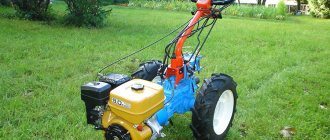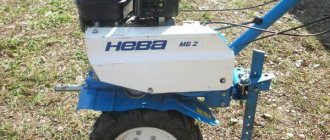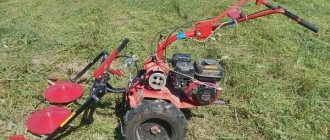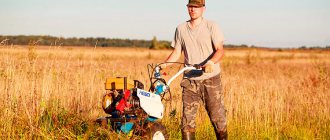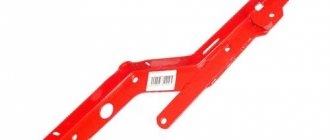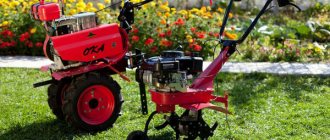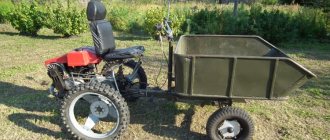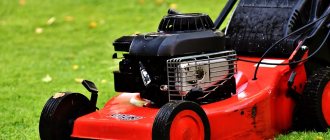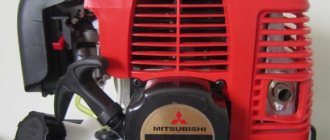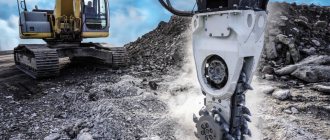Walk-behind tractors and motor-cultivators are indispensable assistants when cultivating small garden plots. They have many advantages: compact size, light weight, ease of transportation. However, these advantages turn into disadvantages when working on heavy and damp soils, processing virgin soil or cultivating slopes. Farmers and gardeners often encounter problems such as wheel slippage and excessive resistance of the unit during operation. You have to lean on it with all your weight to loosen the soil. This is due to the insufficient mass of the unit. Weights for walk-behind tractors solve this problem - a simple device that increases the efficiency of the equipment and makes the farmer’s work easier.
Purpose of weights
Weights are used in the following cases:
- increased adhesion properties;
- improved weight distribution of the front and rear parts;
- making it easier to control the walk-behind tractor.
Weights are required when raising virgin soil, heavy soils, and working on slopes. With loads, less time and effort is spent on soil cultivation. In addition, their use makes it easier to transport goods on uneven rural roads by improving traction. You can purchase factory-made weights or make your own.
Weights improve the performance of the walk-behind tractor
Applications
The Shtenli 1900 Pro Series walk-behind tractor can be used on the following types of soil:
- virgin soil of any type;
- clayey;
- loamy;
- peat;
- calcareous.
It is recommended to treat sandy soils with lighter walk-behind tractors to avoid idle load on the engine or to work in a lower gear, which is also present in the pro series 1900 walk-behind tractor.
The Shtenli 1900 Pro Series device is very simple: the equipment has a classic arrangement of component parts. The hitch, headlight and opener are located at the front of the structure, and the control handles are directed towards the operator.
The steering column is height adjustable. The engine and gearbox are not covered with a protective casing, but this is compensated by the robustness of the structure and the high quality of the housing materials.
Types of weights
Weights are:
- disc - used mainly for wheels;
- plate - for the remaining parts of the walk-behind tractor.
For wheels
Disc weights for walk-behind tractor wheels are mounted on disks, as the name implies. They are thick metal rings with a hole in the middle. In cases of extreme necessity, they can also be made of concrete.
There are two ways to fix them. The easiest option is to weld it. It is suitable in cases where the equipment is constantly used on heavy soils, and there is no need to take it to the city at the end of the season. In this case, it is quite possible to install non-removable welded weights.
Be sure to read: Technical characteristics of ROU-6
In other cases, it will be more convenient and practical to secure the loads with bolts. Weights are not needed when mowing grass, transporting loads on a flat road and other light work. Removable weights will ensure free weight adjustment depending on conditions and, if necessary, facilitate transportation of the walk-behind tractor.
It is important to remember that the total weight of wheel loads should not exceed 50 kg. Overloading will lead to increased wear on axles and hubs. It is recommended to check with the seller for the exact load level for a specific model.
To the body
If a farmer is faced with the question of not only how to make a walk-behind tractor heavier, but also how to improve weight distribution, it is worth paying attention to plate weights. They are metal bars that are attached to the body. Can be used in combination with wheeled ones. As is the case with wheeled weights, they can be removable or non-removable. It is recommended to give preference to threaded connections.
Wheel weights
For lugs
Weights for lugs are installed in the same way as wheel weights. The fastening depends on the design of the lugs: they can be installed with the main wheels removed or mounted on top. Some farmers simply fill the central part of the lugs with concrete, but if possible, it is worth giving preference to more gentle and technical options.
Tools for home and garden, handicrafts, etc. prices are very low
The walk-behind tractor has enough power, even though it is petrol. Large 5/12 wheels provide excellent traction... There is only one reason left - the low weight of the walk-behind tractor (according to the passport - 125 kg).
I started looking for a way to fix this problem.
It turns out there are several methods.
- 1. Make a weighting mold in sand and pour molten lead into it (too difficult).
- 2. Make weights from a mixture of concrete and crushed stone (cheap, but short-lived).
- 3. Fill a container with sand and hang it on a walk-behind tractor (unreliable, inconvenient).
What if you increase the weight of the walk-behind tractor using metal weights?
I went to a collection point for ferrous metals, where I found several weights of different weights from old industrial scales from the times of the USSR, and a couple of weights from a sports barbell weighing 10 kg. two clutch baskets with flywheels from VAZ 2101 -2107 cars and one counterweight for 25 kg from a tractor.
In a local shop with spare parts for walk-behind tractors, I bought an additional section of cutters for the walk-behind tractor - a faceted tube with a diameter of 32 mm and a length of 15-20 cm, on which four cutter blades are installed. Now I had all the details of the future weighting materials collected.
First of all, I installed a couple of 10-kilogram weights from the scales on the “back” of the walk-behind tractor (that is, on the gearbox, where in theory the battery should be installed if it were included in the kit). Giri pre-welded together. I attached them to the gearbox housing with two 12 mm bolts. Using a second pair of 12 mm bolts, I secured the same weights to the steering wheel bracket of the walk-behind tractor.
Then, from a 40/40 mm corner, I welded a frame for a 25-kilogram weight from a tractor. It looks like a pancake with a diameter of 30 cm and a thickness of 8 cm, in the middle of which there is a slot in the shape of the letter T. He placed the weight in a frame and tightened it with a nut so that it would not fall during the work. The structure was installed on top of the weights. The weight of the walk-behind tractor has increased by 48 kg!
Making weights with your own hands
For most models, you can buy ready-made weights. They cost from 1000 to 5000 rubles, depending on weight and configuration. For example, wheel weights for the Neva MB-2 walk-behind tractor cost from 1,500 rubles per 10 kg and about 1,200 rubles. for 8 kg. Hull weights will cost 1,200 rubles for 18 kg, and a kit for lugs - from 5,000 rubles for 20 kg. By the standards of a large farm, the money is small, but on a small farm, where, in addition, there are the necessary materials and tools, you can make the loads yourself.
Be sure to read: Buy an MTZ cabin
To make wheel weights for a walk-behind tractor with your own hands, you will need the following materials:
- two regular sports weights of 5 kg each;
- 10 kg weight plates;
- old car clutch baskets;
- solid metal profile with hexagonal cross-section;
- cotter pins for walk-behind tractor.
Required tools:
- welding machine;
- grinder with cutting wheel;
- electric drill;
- paint, brush, solvents for final painting.
Stages of work:
- Cut a piece about 5 cm long from the metal profile and drill holes in it for the cotter pins.
- Attach a piece of the profile to the bar plate: insert it into the hole from the bar and weld it.
- Weld the clutch basket to the pancake, and the weight to the basket.
- Repeat for the second weight.
- Paint, let dry and install on rims. Secure the cotter pin with steel wire.
You can make your own weighting agent
As a result, the weight of the walk-behind tractor will increase by 50 kg.
For body weights, a frame is first made. The work order is as follows:
- Weld a box-shaped frame from an angle profile and make holes for the bolts.
- Weld bolts with a diameter of 12 mm and a length of at least 10 cm to the gearbox housing and to the steering wheel bracket.
- Install the frame on the frame and adjust it so that the walk-behind tractor, standing without support, does not fall forward or backward.
- Remove the frame, paint and install again. Pick up the load and fill the frame with it.
You can find the materials you need at a scrap metal collection point. In addition, many people may have everything they need in their garage or workshop.
Specifications
Shtenli 1900 is equipped with a gear drive, the crankshaft has a horizontal orientation. The working width of the walk-behind tractor ranges from 80 to 100 cm and is adjustable by the operator.
The depth of work with the soil is standard - 30 cm. Stanley has quite large dimensions: 190x140x90 cm. At the same time, its maneuverability, speed and productivity remain at a high level.
Shtenli weight of this model is 178 kg. This is heavy equipment capable of quickly plowing virgin soil or transporting a load weighing up to 500 kg in a cart. The manufacturer provides a 2-year warranty on the device.
How to install weights
When plowing, loads are placed on the front drawbar. When milling - between the steering wheel bracket and the gearbox so that the walk-behind tractor stands level, without tilting forward or backward. Before doing this, you should determine the center of gravity and ensure that it moves as low as possible.
The total weight of the loads should not exceed 100 kg, and the continuous operation time should not exceed 1 hour. Exceeding the load will lead to premature wear of the transmission and constant overload of the motor.
Be sure to read: How to milk a cow correctly
Operation and Maintenance
Operation and maintenance of the Shtenli 1900 pro series walk-behind tractor are carried out in accordance with the following rules:
- running in from 8 to 10 hours, engine load - 2/3 power;
- engine oil - SAE5W-30 (synthetic in winter, semi-synthetic in summer), transmission oil - 80W-90 (or equivalent viscosity);
- oil change - after break-in, then every 50 operating hours;
- during storage, the walk-behind tractor is left with an empty gas tank and oil sump;
- store the device at above-zero temperatures;
- Once a year, replace or clean the spark plug, oil and gasoline filters.
Eurosystems for the p-70 walk-behind tractor
This product has limited functionality - it is only suitable for a specific modification of the walk-behind tractor - Eurosystems P-70.
This equipment from the Italian manufacturer is popular in Russia, which is why the weighting material for it is included in the rating under consideration. The weight is an elongated cylinder with a steel knob. The product is fastened to a specially designated place on the walk-behind tractor frame. The load is painted red, just like the equipment itself, and is practically invisible on the unit. The device is designed to create minimal interference to the operator during operation.
The weighting agent showed itself best in such work as plowing with a hiller, loosening, digging up potatoes, and transporting a trailer. The product is designed in such a way as to move the center of gravity down the unit to give it greater stability, to increase traction with the soil surface in order to increase traction. The average price is 6,300 rubles.
Eurosystems for the R-70 walk-behind tractor
Advantages:
- attractive appearance;
- compact sizes.
Flaws:
- high price;
- The product is made for a specific walk-behind tractor model; for use with equipment from another manufacturer, some modifications are required.
MB forza square ut 30.290.12
As the name implies, this model is a square-shaped plate. In the center of each square there is a mounting hole for mounting garden equipment on the wheel axle. Mounting holes are drilled along the perimeter at an equal distance from the center. The plates are painted brown and are suitable for the same walk-behind tractors as the previous model.
The plates are best suited for use on lugs and transport wheels, and it is recommended to install them on the inside so that they do not interfere with the operator during operation. If you really want, you can try to install them on the front drawbar, but you will have to tinker.
MB Forza Square UT 30.290.12
Advantages:
- low price compared to round pancakes with equal characteristics;
- complete set of delivery (including fasteners).
Flaws:
- inconvenient shape, which is why not on every walk-behind tractor the plates can be placed ergonomically for the user.
